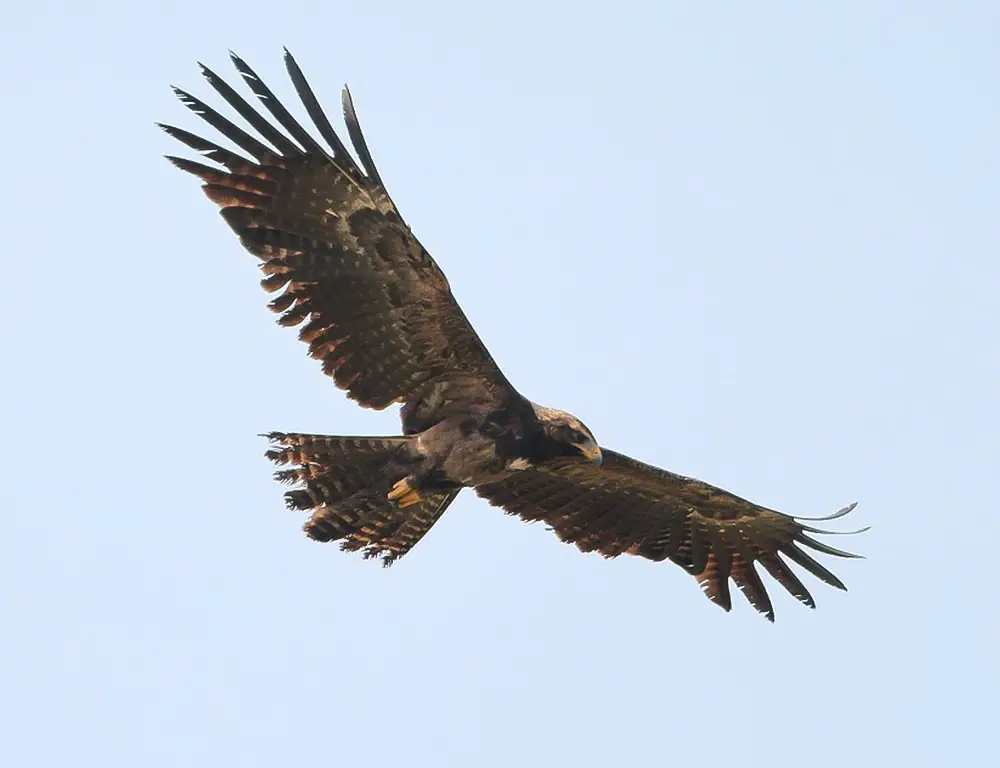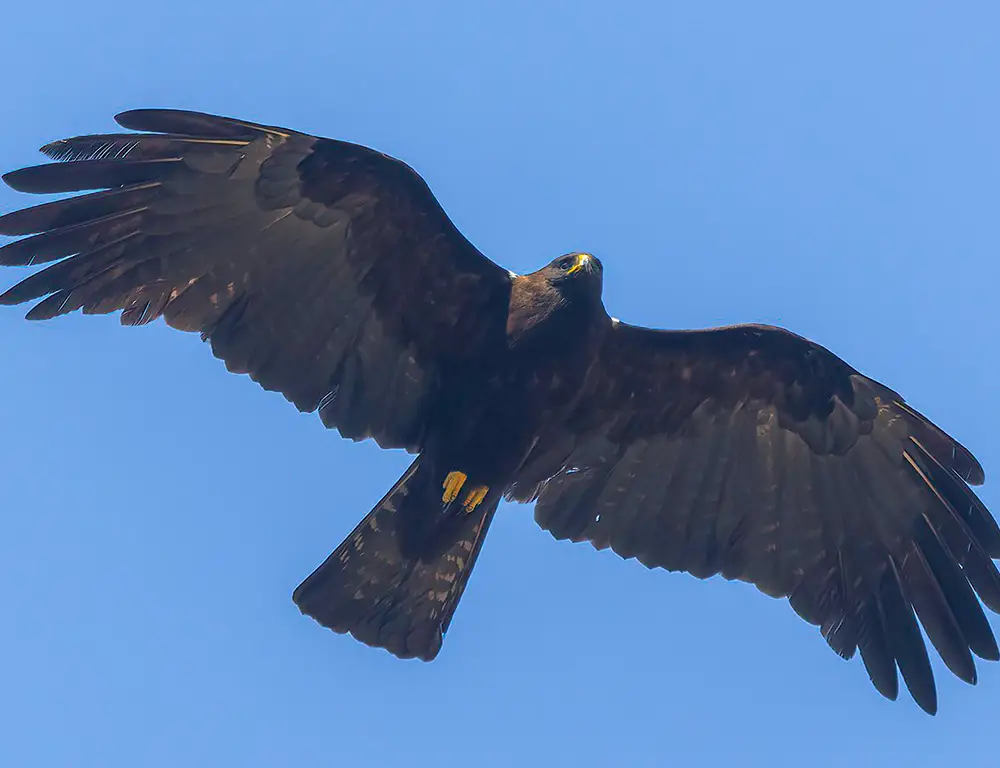The Black Eagle (Ictinaetus malaiensis) is a magnificent symbol of nature’s avian aristocracy, captivating observers with its commanding presence and unparalleled aerial prowess.
As one of the most iconic raptors in forested habitats across its range, this majestic bird commands respect and admiration from scientists, birdwatchers, and cultural enthusiasts alike.
With its sleek black plumage, piercing yellow eyes, and powerful talons, the Black Eagle embodies strength, power, and grace.
Beyond its physical attributes, this avian aristocrat plays a crucial role in maintaining ecosystem balance as a top predator, preying on various small to medium-sized animals.
Furthermore, its cultural significance transcends borders, with myths, folklore, and artistic representations celebrating its symbolic importance.
Join us as we delve into the captivating world of the Black Eagle, exploring its ecological significance and cultural resonance. Stay focused.

Taxonomy and Classification of Black Eagle
Taxonomy refers to the science of categorizing organisms based on their evolutionary relationships.
The classification system used in taxonomy organizes living organisms into a hierarchical structure, ranging from broad categories like kingdom down to specific species.
Taxonomic classification helps scientists understand the relationships between different species and provides a framework for studying biodiversity and evolutionary history.
Check out the table below detailing the taxonomical classification of the Black Eagle (Ictinaetus malaiensis):
| Kingdom | Animalia |
| Phylum | Chordata |
| Class | Aves |
| Order | Accipitriformes |
| Family | Accipitridae |
| Genus | Ictinaetus |
| Species | Ictinaetus malaiensis |
The Black Eagle, scientifically known as Ictinaetus malaiensis, belongs to the Animalia kingdom, Chordata phylum, Aves class, Accipitriformes order, and Accipitridae family. It is the only member of the Ictinaetus genus.
The Black Eagle (Ictinaetus malaiensis) comprises two recognized subspecies:
- Ictinaetus malaiensis malaiensis (Temminck, 1822): This subspecies is found from Myanmar to southern China, Southeast Asia, and Indonesia. Its range encompasses diverse forested habitats, including tropical rainforests, montane forests, and subtropical forests.
- Ictinaetus malaiensis perniger (Hodgson, 1836): This subspecies inhabits distinct regions within the Indian subcontinent. It is found in northern India, Nepal, southern India, and Sri Lanka. Its habitat includes a mix of forested landscapes, ranging from lowland forests to foothills and montane regions.
These subspecies exhibit slight variations in plumage coloration, size, and possibly behavior, reflecting adaptations to their respective environments.
Studying these subspecies provides valuable insights into the evolutionary history and ecological dynamics of the Black Eagle across its range.
How to Identify Black Eagle?

Identifying a Black Eagle (Ictinaetus malaiensis) requires a keen eye and attention to detail, especially considering its resemblance to other large birds of prey. Here are some key characteristics to help identify a Black Eagle:
Size and Shape
Black Eagles are large raptors with a wingspan typically ranging from 150 to 180 centimeters (about 59 to 71 inches).
They have broad wings and a relatively short, rounded tail. They appear powerful and soaring in flight, often gliding with little flapping.
Plumage Coloration
Despite their name, Black Eagles do not appear entirely black. Their plumage is primarily dark brown to black with a glossy sheen.
The head and neck are typically darker than the rest of the body, and adults may have a distinctive white patch or band on the underwing.
Underwing Pattern
From below, Black Eagles display a distinctive pattern on their underwings.
Look for a broad white band along the wing’s leading edge, contrasting with the dark plumage of the rest of the wing. This white band is often visible even from a distance.
Facial Features
Black Eagles have large, powerful beaks and piercing yellow eyes. The facial skin is typically a pale yellow to grayish color. Juveniles may have paler eyes and less distinct facial markings compared to adults.
Habitat and Behavior
Black Eagles are typically found in forested habitats, ranging from lowland tropical forests to montane forests.
They may soar high above the forest canopy or perch conspicuously on tall trees, scanning for prey. Graceful glides and occasional wing flaps often characterize their flight.
Voice
While not often vocal, Black Eagles may produce a series of high-pitched whistles or screams, especially during the breeding season or when defending territory.
Familiarizing yourself with their vocalizations can aid identification, but they are generally not as vocal as other bird species.
Comparison with Similar Species
When identifying a Black Eagle, it’s essential to differentiate it from other large birds of prey in its range, such as the Crested Serpent Eagle or other eagle species.
Pay attention to plumage details, wing shape, and habitat preferences to distinguish between similar species.
By observing these characteristics and paying attention to details, birdwatchers and enthusiasts can successfully identify the majestic Black Eagle in its natural habitat.
Habitat and Distribution of Black Eagle
The Black Eagle (Ictinaetus malaiensis) is distributed across a wide range from the Indian subcontinent through Southeast Asia and into parts of southern China and the Indonesian archipelago.
Its habitat preferences vary slightly across its range but generally include forested areas, ranging from lowland tropical forests to montane forests.
Here’s a breakdown of the habitat and distribution of the Black Eagle:
Indian Subcontinent
The Black Eagle is found in various forested habitats in India, including the Western Ghats, Eastern Ghats, Himalayan foothills, and parts of central and northeastern India.
It inhabits lowland and montane forests, often preferring areas with dense tree cover.
Southeast Asia
The Black Eagle is widespread in Southeast Asia, occurring in Myanmar, Thailand, Laos, Cambodia, Vietnam, Malaysia, and Indonesia.
It is commonly found in primary and secondary forests, including lowland and montane. In Indonesia, it occurs on several islands, including Sumatra, Java, and Borneo.
Southern China
The Black Eagle is in parts of southern China, particularly in regions with suitable forested habitats. It can be found in provinces such as Yunnan and Guangxi, where it inhabits subtropical and tropical forests.
Habitat Preferences
Within its range, the Black Eagle prefers mature forests with tall trees, dense canopies, and ample prey availability.
It may also inhabit forest edges and partially cleared areas as long as suitable hunting grounds are available.
While it primarily resides in forested habitats, it may occasionally venture into open areas adjacent to forests.
Altitudinal Range
The altitudinal range of the Black Eagle varies across its distribution. In some regions, it may occur from sea level up to elevations exceeding 2,000 meters (6,500 feet).
In mountainous areas such as the Himalayas, it is often found at higher elevations, while in lowland regions, it may inhabit coastal areas and plains.
The Black Eagle demonstrates adaptability to various forested habitats throughout its range, from the dense tropical rainforests of Southeast Asia to the subtropical forests of southern China and the montane forests of the Himalayas.
Despite facing threats such as habitat loss and degradation, it remains relatively widespread and is often encountered by birdwatchers and researchers in suitable habitats across its range.
Black Eagle’s Diet and Feeding Behavior
The Black Eagle (Ictinaetus malaiensis) is a formidable raptor with a diverse diet and distinct feeding behaviors. Here’s an overview of its diet and feeding behavior:
Carnivorous Diet
Black Eagles are carnivores, primarily preying on various small to medium-sized animals. Their diet typically consists of mammals, birds, reptiles, and occasionally, insects and other invertebrates.
Primary Prey
Small to medium-sized mammals form a significant portion of the Black Eagle’s diet.
This may include rodents like squirrels, rats, mice, and small mammals like bats. They are also known to prey on birds, including pigeons, doves, and smaller raptors.
Hunting Techniques
Black Eagles employ various hunting techniques to capture prey. They are skilled aerial hunters and often hunt by soaring high above the forest canopy, scanning for potential prey items.
Once prey is spotted, they may stoop or dive down to capture it with their paws. They also perch on prominent vantage points, waiting for prey to come within striking distance.
Ambush Predators
Like many raptors, Black Eagles are ambush predators, relying on stealth and surprise to capture their prey. They may use trees or other natural features to conceal themselves while waiting for an opportune moment to strike.
Occasional Scavenging
While primarily hunting live prey, Black Eagles are opportunistic feeders and may scavenge carrion when the opportunity arises. They may compete with other scavengers, such as vultures and large carnivores, to access carcasses.
Feeding Behavior
After capturing prey, Black Eagles typically consume their meal on a perch or secluded spot within their territory.
They use their powerful beak and talons to tear apart the prey and consume it in bite-sized pieces. Larger prey items may be carried to a feeding site or cached for later consumption.
Feeding Young
During the breeding season, Black Eagles provide food for their young by hunting and bringing prey items back to the nest.
Both parents participate in feeding the chicks, with the female often remaining at the nest to brood while the male hunts and brings food.
So, the Black Eagle is an efficient predator with a varied diet and specialized hunting techniques. Its ability to adapt to different prey types and hunting strategies contributes to its success as a top predator in its forested habitats.
Cultural Significance of Black Eagle
The Black Eagle (Ictinaetus malaiensis) holds cultural significance in various societies across its range, often revered for its majestic appearance, hunting prowess, and symbolic associations.
Here are some examples of the cultural significance of the Black Eagle:
Symbol of Strength and Power
The Black Eagle symbolizes strength, power, and freedom in many cultures.
Its impressive size, aerial prowess, and sharp talons evoke bravery and dominance, leading to its portrayal in folklore, myths, and heraldry as a symbol of strength and nobility.
Spiritual and Mythological Symbolism
In some indigenous cultures, the Black Eagle is imbued with spiritual significance and is considered a messenger between the earthly realm and the spirit world.
It may be associated with deities or spirits of the sky and is believed to possess mystical powers.
Hunting Traditions
In specific communities, the hunting prowess of the Black Eagle is admired and celebrated. Traditional hunters may observe the behavior of Black Eagles to locate prey or seek guidance from the birds during hunting expeditions.
Ceremonial Practices
The Black Eagle may feature in ceremonial practices and rituals, particularly those related to rites of passage, initiation ceremonies, or spiritual ceremonies. Its presence may be invoked for protection, guidance, or blessings.
Art and Literature
The striking appearance of the Black Eagle often inspires artists, poets, and writers, who incorporate its imagery into their creative works.
It may appear in paintings, sculptures, poetry, and literature as a symbol of beauty, freedom, or wilderness.
Conservation and Environmental Awareness
As awareness of environmental issues grows, the Black Eagle has become a conservation and environmental protection symbol.
Its presence in ecosystems signifies the importance of preserving natural habitats and biodiversity.
Tourism and Ecotourism
Regions where the Black Eagle is found may attract birdwatchers, nature enthusiasts, and eco-tourists seeking to observe these magnificent birds in their natural habitat.
Tourism initiatives focused on birdwatching and wildlife conservation may contribute to local economies while raising awareness about the importance of protecting the species and its habitat.
The Black Eagle occupies a prominent place in the cultural landscape of many societies, serving as a symbol of strength, spirituality, and natural beauty.
Its cultural significance reflects humanity’s deep-seated connection to the natural world and underscores the importance of conserving these majestic birds and their habitats for future generations.
Wrapping Up
The Black Eagle (Ictinaetus malaiensis) captivates both scientists and cultural enthusiasts alike with its impressive hunting skills, symbolic significance, and ecological importance.
As a top predator in forested habitats across its range, it is crucial to maintaining ecosystem balance.
Furthermore, its cultural significance highlights humanity’s deep connection to the natural world and underscores the importance of conservation efforts to protect these majestic birds. I appreciate your support.